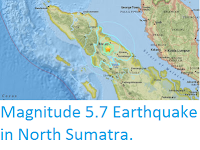Flights have been cancelled and thousands of people have been evacuated after Mount Sinabung, a 2460 m stratovolcano (cone shaped volcano made
up of layers of ash and lava) in North Sumatra, Indonesia, erupted suddenly at about 9.30 am on Monday 19 February 2018, producing a column of ash estimated to be over 7250 m high, accompanied by falling ash and even rockfalls in local communities. Local authorities have responded by evacuating communities within 7 km and cancelling flights over North Sumatra.
Sinabung is considered to be a potentially very dangerous volcano, as a large number of people live in its
immediate vicinity. The last major eruption prior to the twenty-first
century happened in about 1600, with small eruptions occurring in 1889
and 1912. However the volcano returned to life in late August 2010,
erupting throughout September and causing about 12 000 people to flee
their homes, and has been erupting intermittently ever since.
The location of Mount Sinabung. Google Maps.
The
Indo-Australian Plate, which underlies the Indian Ocean to the west of
Sumatra, is being subducted beneath the Sunda Plate, a breakaway part of
the Eurasian Plate which underlies Sumatra and neighbouring Java, along
the Sunda Trench, passing under Sumatra, where friction between the two
plates can cause Earthquakes. As the Indo-Australian Plate sinks further
into the Earth it is partially melted and some of the melted material
rises through the overlying Sunda Plate as magma, fuelling the volcanoes
of Sumatra.
The two plates are not directly impacting one-another, as occurs in the subduction zones along
the western margins of North and South America, but at a steeply
oblique angle. This means that as well as the subduction of the
Indo-Australian plate beneath the Sunda, the two plates are also moving
past one-another. This causes rifting within the plates, as parts of
each plate become stuck to the other, and are dragged along in the
opposing plate's direction. The most obvious example of this is the
Sumatran Fault, which runs the length of Sumatra, with the two halves of
the island moving independently of one-another. This fault is the cause
of most of the quakes on the island, and most of the island's volcanoes
lie on it.
The movement of the tectonic plates around Sumatra. NASA/Earth Observatory.
See also...
Follow Sciency Thoughts on Facebook.










